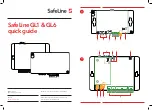
198
C
HAPTER
3: D
EVICE
C
ONFIGURATION
5
To map the buttons that you want, follow these steps:
a
Select the appropriate column of buttons. Click
1-50
to select columns
A through E, or
51
through
100
to select columns F through J. (This
choice emulates the function of the
Shift
button on the physical
Attendant Console.)
b
Click the letter (
A
through
J
) that corresponds to the column of
buttons that you want to map.
c
Map the buttons for the column that you selected using the
pull-down list boxes. Table 31 describes each mapping type.
Table 31
Attendant Console Button Mappings
Button Type
Description
Default
If you select this setting for a button and click
Apply
, the
default value defined for the telephone group is applied
to this button.
Example:
You have set a button on a user’s telephone as
a hunt group login button, but the user no longer wants
to use the button this way.
You select Default for the button and click Apply.
If the normal setting for the button (defined for the
corresponding telephone group) is PSD12 (personal
speed dial 12) that setting becomes active on the button.
Number
— Not used.
Prty
(Priority) — Not used.
Other
Lets you assign any feature code to a button.
Number
— Enter the feature code number in this field.
Prty
(Priority) — Not used.
Example: On the NBX 100, use
Other
to map the
personal speed dials from 11–99. In the
Number
field,
enter an extension from the personal speed dial
extension range. PSD 11 corresponds to extension 610.
Feature
A
Feature
button lets you access any system feature by
pressing it and then dialing a Feature Code.
For example, if a telephone does not have a button
programmed for Call Park, you can press the Feature
button, and then dial the Call Park Feature Code (444) to
access the Call Park feature.
Number
— Not used.
Prty
(Priority) — Not used.
Summary of Contents for NBX 100
Page 14: ......
Page 18: ...18 ABOUT THIS GUIDE ...
Page 26: ...26 CHAPTER 1 INTRODUCTION ...
Page 138: ...138 CHAPTER 2 DIAL PLAN ...
Page 322: ...322 CHAPTER 3 DEVICE CONFIGURATION ...
Page 328: ...328 CHAPTER 4 USER CONFIGURATION ...
Page 412: ...412 CHAPTER 10 TROUBLESHOOTING ...
Page 458: ...458 APPENDIX B ISDN COMPLETION CAUSE CODES ...
Page 480: ...480 GLOSSARY ...
Page 492: ...492 INDEX ...
















































